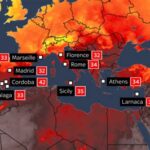
Earth’s shifting magnetic field, a phenomenon known as a geomagnetic reversal, produces eerie sounds when simulated, likened to something from a horror movie, according to scientists studying the Earth’s inner workings.
Scientists from the Technical University of Denmark (DTU) have created a sound model of Earth’s magnetic field, revealing unsettling noises arising from the turbulent flow of liquid iron within the planet’s core. The simulation, based on data from the European Space Agency’s Swarm satellite mission, offers new insights into the complex dynamics that drive the geomagnetic field and its potential for future reversals.
The simulation captures a range of unsettling auditory effects including buzzing, gurgling, and whining sounds. These are generated by the complex interactions within the core, where the motion of molten iron generates electrical currents, which in turn create the magnetic field. “We made a sound model of the Earth’s magnetic field, and it does sound rather scary,” said DTU professor Klaus Nielsen.
The Earth’s magnetic field, which extends thousands of kilometers into space, acts as a shield, protecting the planet from harmful solar winds and cosmic radiation. These charged particles, emitted by the sun, can strip away the atmosphere and pose significant dangers to life. Without this magnetic shield, Earth would be a very different, and likely uninhabitable, planet.
Geomagnetic reversals, where the magnetic north and south poles swap places, have occurred numerous times throughout Earth’s history. The timing of these events is unpredictable, and the process can take hundreds to thousands of years to complete. While the exact consequences of a future reversal are still under investigation, scientists anticipate potential disruptions to navigation systems, satellite communications, and power grids.
The Swarm mission, launched in 2013, consists of three identical satellites orbiting Earth, precisely measuring the magnetic field’s strength and direction. Data from these satellites, combined with sophisticated computer models, has allowed scientists to create detailed simulations of the geodynamo – the process by which Earth’s magnetic field is generated and maintained. The auditory representation is just one way to help visualize and understand the complex data obtained from the satellite mission.
The sounds produced in the model are directly related to the speed and direction of the liquid iron flow within the core. Rapid changes in flow patterns and magnetic field lines can create intense electrical currents, resulting in the unsettling noises captured in the simulation. The project aims to foster better understanding of the complex forces that govern the planet’s magnetic field.
While the auditory simulation provides a unique and somewhat alarming perspective, it underscores the vital role of the Earth’s magnetic field in protecting life on the planet. Continuous monitoring and advanced research efforts, such as the Swarm mission, are crucial for understanding the dynamics of the field and mitigating the potential risks associated with future geomagnetic reversals.
The simulation of Earth’s magnetic field is not just an academic exercise; it offers valuable insights into the complex processes occurring deep within the planet. By converting complex data into an audible form, researchers hope to engage a broader audience and enhance understanding of this critical planetary feature.
In-depth Exploration of Earth’s Magnetic Field and Geomagnetic Reversals
The Earth’s magnetic field is not static; it’s a dynamic and constantly evolving phenomenon shaped by the turbulent flow of molten iron in the Earth’s outer core, located approximately 2,900 kilometers (1,800 miles) beneath the surface. This molten iron, a highly conductive fluid, generates electric currents as it moves, creating a self-sustaining dynamo that produces the magnetic field. This process is known as the geodynamo.
Understanding the Geodynamo
The geodynamo is driven by two primary factors:
- Convection: Heat from the Earth’s interior causes the molten iron to rise, while cooler, denser iron sinks. This convective motion is similar to the boiling of water in a pot.
- Coriolis Effect: The Earth’s rotation influences the direction of the molten iron flow, causing it to spiral and twist. This effect is similar to how weather patterns are influenced by the Earth’s rotation.
The interaction between these two forces creates a complex and chaotic flow pattern in the outer core. The resulting electric currents generate magnetic fields, which in turn influence the flow of the molten iron. This feedback loop sustains the geodynamo and maintains the Earth’s magnetic field.
Geomagnetic Reversals: A History of Pole Swaps
The Earth’s magnetic field is not always aligned with the geographic poles. In fact, it has reversed its polarity numerous times throughout Earth’s history. During a geomagnetic reversal, the magnetic north and south poles effectively swap places. Evidence of these reversals is found in the magnetic orientation of iron-rich minerals in ancient rocks. As molten rock cools and solidifies, these minerals align themselves with the prevailing magnetic field, preserving a record of its direction at the time.
Scientists have identified hundreds of geomagnetic reversals in the geological record, dating back hundreds of millions of years. The frequency of these reversals varies over time. There have been periods with frequent reversals and periods with long intervals of stable polarity. The last major reversal occurred approximately 780,000 years ago, known as the Brunhes-Matuyama reversal.
The Process of Reversal: A Gradual Transition
Geomagnetic reversals are not instantaneous events. They are gradual processes that can take hundreds to thousands of years to complete. During a reversal, the magnetic field weakens and becomes more complex, with multiple magnetic poles appearing at the Earth’s surface. The magnetic field lines become tangled and distorted, and the overall strength of the field decreases significantly.
As the reversal progresses, the magnetic poles wander erratically across the globe before eventually settling into their new positions. The entire process can take several centuries to several millennia, during which the Earth’s magnetic shield is weakened, making the planet more vulnerable to solar radiation.
Potential Consequences of a Geomagnetic Reversal
The exact consequences of a future geomagnetic reversal are still uncertain. However, scientists have identified several potential impacts:
- Increased Radiation Exposure: During a reversal, the weakened magnetic field provides less protection from harmful solar radiation and cosmic rays. This could lead to an increase in radiation exposure at the Earth’s surface, potentially increasing the risk of cancer and other health problems.
- Disruption of Navigation Systems: Many navigation systems, including those used by airplanes and ships, rely on the Earth’s magnetic field for orientation. A reversal could disrupt these systems, making navigation more difficult and potentially leading to accidents.
- Satellite Disruptions: Satellites orbiting the Earth are also vulnerable to solar radiation. A weakened magnetic field could increase the risk of satellite damage or malfunction, disrupting communication, weather forecasting, and other vital services.
- Power Grid Vulnerability: Solar flares and coronal mass ejections (CMEs) can induce electrical currents in the Earth’s surface. A weakened magnetic field could make power grids more vulnerable to these currents, potentially leading to widespread blackouts.
- Impact on Wildlife: Some animals, such as birds and sea turtles, use the Earth’s magnetic field for navigation. A reversal could disrupt their migratory patterns and potentially harm their populations.
The Swarm Mission: Monitoring Earth’s Magnetic Field
The European Space Agency’s (ESA) Swarm mission is a constellation of three identical satellites launched in 2013 to study the Earth’s magnetic field in unprecedented detail. The Swarm satellites are equipped with highly sensitive magnetometers that measure the strength and direction of the magnetic field.
The Swarm mission provides valuable data for understanding the geodynamo and monitoring changes in the Earth’s magnetic field. The data from Swarm are used to create detailed models of the magnetic field, which help scientists to predict future changes and assess the potential risks associated with geomagnetic reversals.
“The Swarm satellites provide the best ever survey of the magnetic field and allow us to pick apart its various sources,” said Rune Floberghagen, ESA’s Swarm mission manager.
The Sound of the Magnetic Field: A New Way to Understand the Geodynamo
The recent auditory simulation of Earth’s magnetic field provides a new and innovative way to understand the complex processes occurring within the Earth’s core. By converting the data from the Swarm mission into sound, scientists can gain a different perspective on the dynamics of the geodynamo.
The sounds produced in the simulation are directly related to the speed and direction of the liquid iron flow within the core. Rapid changes in flow patterns and magnetic field lines create intense electrical currents, which result in the unsettling noises captured in the simulation.
While the auditory simulation may sound alarming, it underscores the vital role of the Earth’s magnetic field in protecting life on the planet. It also highlights the importance of continuous monitoring and advanced research efforts, such as the Swarm mission, to understand the dynamics of the field and mitigate the potential risks associated with future geomagnetic reversals.
Preparing for a Geomagnetic Reversal
While the exact timing and consequences of a future geomagnetic reversal are uncertain, it is important to be prepared. Governments and organizations around the world are working to:
- Improve Monitoring Systems: Investing in advanced monitoring systems, such as the Swarm mission, to track changes in the Earth’s magnetic field and provide early warnings of potential reversals.
- Strengthen Infrastructure: Hardening critical infrastructure, such as power grids and communication networks, to make them more resilient to the effects of solar radiation and geomagnetic disturbances.
- Develop Alternative Navigation Systems: Developing alternative navigation systems that do not rely on the Earth’s magnetic field, such as satellite-based navigation systems (e.g., GPS).
- Educate the Public: Raising public awareness about the potential risks associated with geomagnetic reversals and providing information on how to prepare for such events.
The Earth’s magnetic field is a vital shield that protects our planet from harmful solar radiation. Understanding its dynamics and preparing for potential reversals is crucial for ensuring the long-term sustainability of life on Earth.
Quotes from Experts
- “We made a sound model of the Earth’s magnetic field, and it does sound rather scary,” said DTU professor Klaus Nielsen.
- “The Swarm satellites provide the best ever survey of the magnetic field and allow us to pick apart its various sources,” said Rune Floberghagen, ESA’s Swarm mission manager.
Further Research and Resources
- European Space Agency (ESA) Swarm Mission: https://www.esa.int/Applications/Observing_the_Earth/Swarm
- Technical University of Denmark (DTU): https://www.dtu.dk/
- National Oceanic and Atmospheric Administration (NOAA) Space Weather Prediction Center: https://www.swpc.noaa.gov/
- United States Geological Survey (USGS) Geomagnetism Program: https://www.usgs.gov/natural-hazards/geomagnetism/science/geomagnetism-program
FAQ: Frequently Asked Questions about Earth’s Magnetic Field and Geomagnetic Reversals
Q1: What is the Earth’s magnetic field and why is it important?
A1: The Earth’s magnetic field is a region of space surrounding the Earth where magnetic forces are present. It is generated by the movement of molten iron in the Earth’s outer core, a process called the geodynamo. The magnetic field acts as a shield, deflecting harmful solar wind and cosmic radiation that would otherwise strip away the atmosphere and pose a threat to life. Without the magnetic field, Earth would be a much different, and likely uninhabitable, planet. It protects us from radiation and particles emitted from the sun.
Q2: What is a geomagnetic reversal and how often does it happen?
A2: A geomagnetic reversal is a phenomenon where the Earth’s magnetic north and south poles swap places. This is not an instantaneous event but a gradual process that can take hundreds to thousands of years. The frequency of reversals varies over geological time, with periods of frequent reversals and periods of stability. The last major reversal occurred approximately 780,000 years ago. While the timing of the next reversal is unpredictable, scientists study past patterns to estimate future possibilities.
Q3: What are the potential consequences of a geomagnetic reversal?
A3: The potential consequences of a geomagnetic reversal are still under investigation. However, potential impacts include increased radiation exposure at the Earth’s surface (potentially increasing the risk of cancer and other health problems), disruptions to navigation systems (used by airplanes and ships), satellite disruptions (affecting communication and weather forecasting), and vulnerability of power grids to solar flares (potentially leading to blackouts). There could also be impacts on wildlife that use the magnetic field for navigation.
Q4: What is the Swarm mission and how is it helping us understand the Earth’s magnetic field?
A4: The Swarm mission is a European Space Agency (ESA) project consisting of three identical satellites launched in 2013. These satellites orbit Earth and precisely measure the strength and direction of the magnetic field. The data collected by Swarm is used to create detailed models of the magnetic field, providing valuable insights into the geodynamo and monitoring changes in the field. The Swarm mission provides the best survey data to date. These data can be used to pick apart the different sources contributing to the Earth’s magnetic field.
Q5: How can scientists create sound models of the Earth’s magnetic field, and what does it tell us?
A5: Scientists use data from missions like Swarm, combined with sophisticated computer models, to simulate the dynamics of the geodynamo. This involves converting the complex data about the speed and direction of liquid iron flow within the core into audible form. The sounds produced in the model are directly related to changes in flow patterns and magnetic field lines, which generate intense electrical currents. The sound model provides a new way to understand the complex processes occurring within the Earth’s core and helps researchers gain a different perspective on the dynamics of the geodynamo. While these models can sound scary, as reported, it demonstrates the importance of magnetic field activity.









